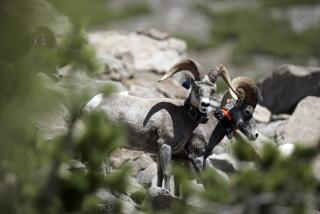Urban pressures on desert bighorns
- Share via
Endangered peninsular bighorn sheep are struggling to survive above the Coachella Valley. The captive breeding program at the Bighorn Institute has added to bighorn numbers, helping prevent their extinction. Habitat loss is the immediate threat to the northern herds, but high predation rates and disease have plagued all sheep in the range.
--
Habitat and urbanization
Peninsular bighorns have suffered as development encroaches on their range in the foothills above the Coachella Valley.
Low-elevation bighorn: from 400 feet to 4,600 feet10
--
Urbanization threats
Loss of connectivity between groups
Toxic plants (oleander)
Parasites
Traffic accidents
Herbicides
Pesticides
Predation from urban coyotes
Behavioral habituation
Sheep abandoning areas frequented by humans and dogs.
Loss of lower elevation grazing areas in spring
--
Natural predators
Coyotes primarily prey on lambs.
Gray foxes and bobcats can take lambs, too.
Mountain lions pose a greater threat in Anza-Borrego than the northern ranges.
--
The rangewide count
The bighorn population reached a low of 276 in 1996, and the species was listed as endangered in 1998.
--
The lambing season
January through June is when bighorn ewes give birth to lambs and form large groups for protection from predators. Although each lamb will suckle only from its mother, all lambs will mingle with other ewes to learn survival skills.
--
Sources: U.S. Fish and Wildlife Service, Bighorn Institute. Graphics reporting by Leslie Carlson
--
Recent regional explainer graphics are available at latimes.com/localgraphics
--
Leslie Carlson Los Angeles Times
More to Read
Sign up for Essential California
The most important California stories and recommendations in your inbox every morning.
You may occasionally receive promotional content from the Los Angeles Times.










